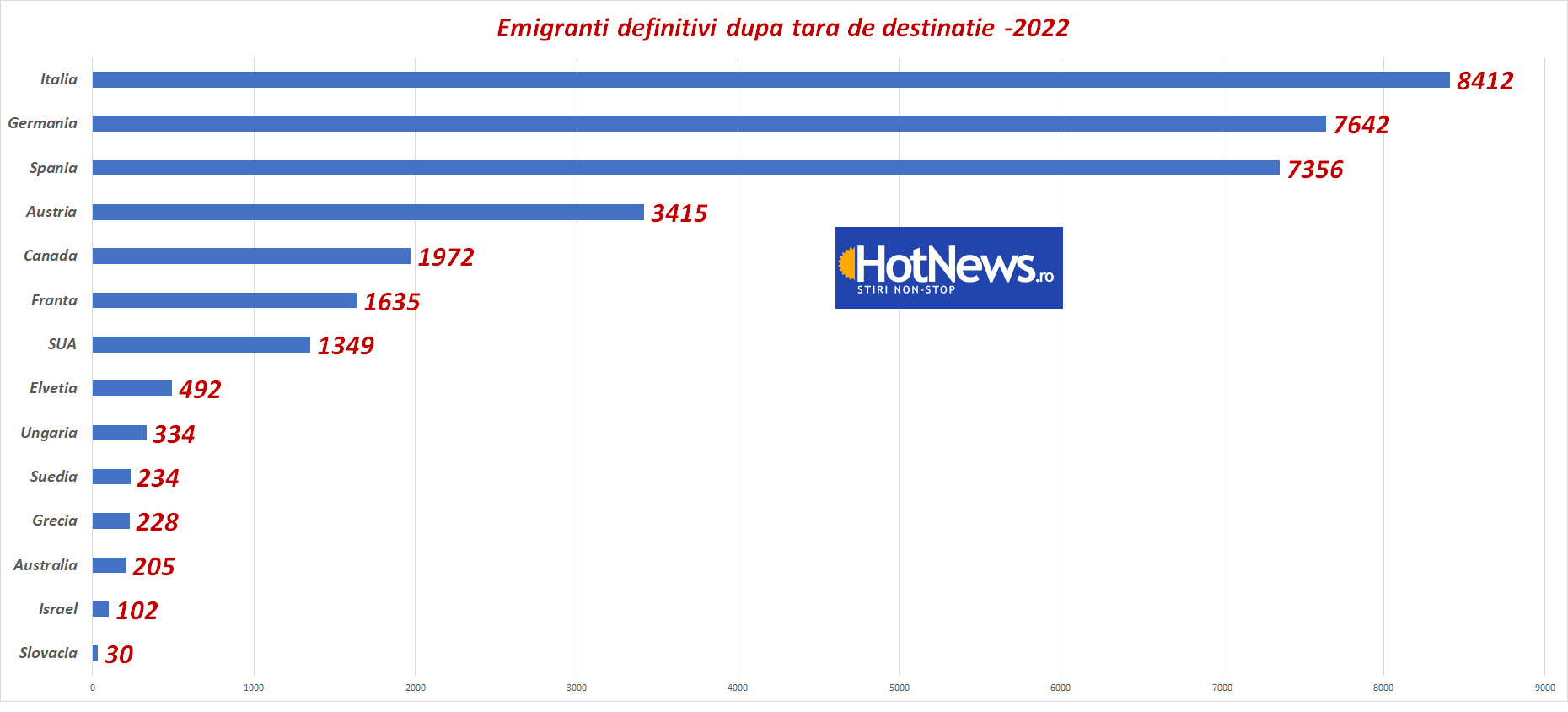
Almost 50,000 Romanians permanently emigrated from Romania in 2022, according to data provided by Statistics. Over the past 10 years, Romania has lost the population equivalent of a medium-sized county due to constant external migration.
These are only permanent emigrants, in addition to them there are also temporary ones who leave either to study or to work, but return to the country.
Below is a chart of counties from which he left permanently over the past 10 years. The order of counties on the graph corresponds to the share of permanent emigrants in the total population (in the capital, the share of “left” is 2.4%, followed by Iasi with 2.39%, Vaslui – 2.28%, and at the other end we have Harghita and Kovasna with less than 0.5%.

Below are permanent emigrants from 2022 by country of destination. The difference of almost 50,000 is those who left for “other countries”, according to statistics.

As I said, there are Romanians who go to study abroad. According to UNESCO, there are more than 15,000 of them and most of them study in Great Britain (almost 10,000), the USA (another 4,903), the Netherlands (about 2,800), Germany (2,500), France (2,439), Hungary (2,200), Denmark (1,724). , Spain (1425), Italy (1400), Austria (1120), Switzerland (428), Belgium (381), Sweden (219), Lithuania (206), Greece (197), Turkey (151), Finland (119) , Canada (about 100). Romania has less than 100 students and each of the following countries: Ireland, Czech Republic, Australia, Norway, Portugal, Japan, Poland, Luxembourg, South Korea, Croatia, Malaysia, Bulgaria, Malta, Cyprus, Brazil, Argentina, Serbia, Estonia, Qatar, Iceland, Ecuador, Slovenia, Monaco and India.
A comprehensive OECD study on Romanian emigrants, conducted in the pre-pandemic year, also analyzes the migration of outgoing Romanians through the prism of the qualifications they possess. The heterogeneity is very large: in countries such as Great Britain and Austria, about one in five Romanians work in highly skilled jobs. Conversely, in Spain and Italy, only 5% of Romanian emigrants occupy highly qualified professions.
Romanian expats tend to be overqualified for the jobs they hold
In OECD countries, one Romanian man in 5 works in basic occupations, compared to one woman in 3. Similarly, women are also overrepresented among those who have found a job in sales (30% vs. 10% of men) and among technicians and professionals ( 10% against 6% of men). Only 4% of women work in trade, while men are significantly more.
Another typically male profession is machine operators and assemblers, where the share of men is four times greater than that of women. However, data at the country level are mixed. In Spain, Romanian women are twice as likely as men to work in low-skilled occupations, in contrast to Germany and the United Kingdom, where women are 10 times less likely to be in low-skilled jobs. The share of women in low-skilled jobs is the lowest in Canada (3%).
Romanian men tend to be overrepresented compared to women and in managerial positions, especially in the United Kingdom, Germany and Canada, with the exception of France, where Romanian women are almost twice as likely as men to be managers. Skilled agricultural occupations are not the main occupation of Romanians, regardless of their gender, although they employ more than 4% of male emigrants in Spain, Italy and France.
In addition, overqualification rates are higher for Romanian emigrants than for emigrants from other countries, OECD data also show. Retraining occurs when a person’s level of education exceeds the skills required for the job they hold.
Among immigrants, the level of overskilling becomes an indicator of the degree of transfer of human capital between countries, since qualifications and language skills acquired in the country of origin are not always easily transferred to the host country. Regardless of gender, Romanians with higher education are 50% more likely to work in low-skilled occupations. For same-type migrants born in neighboring countries, the share is only 26%.
But even more remarkable is the fact that overqualification has increased by 16% for Romanians over the past 20 years, while it has decreased by 7% for emigrants from neighboring countries. These results may reflect Romanians’ relatively low knowledge of the language spoken in the host country, limited access to professional networks, or difficult official recognition of skills acquired abroad, to name just a few of the many factors affecting employment.
A large part of Romanian expatriates feel underutilized at work, as they believe that their potential is not being used to the maximum in the countries to which they emigrate.
When asked if they believe they have the necessary skills to perform tasks more complex than those required for their current job, almost nine in ten Romanian expats agree, compared to 81% of local workers.
The authors of the study note that skills underutilization and skill mismatch are important for the proper integration of migrants because they affect workers’ earnings and job satisfaction.
In Italy and Spain, significant sections of the Romanian emigrant population are employed in agriculture – 9% and 12%, respectively, and in the household – 15% and 12%. On the other hand, in Belgium and the United Kingdom, approximately 23% and 11% of Romanians work in administrative and support services, respectively. Romanian workers play an important role in the industries of Germany and Austria, while in Canada they make – more than in any other country – a significant contribution to the education system
Source: Hot News
Lori Barajas is an accomplished journalist, known for her insightful and thought-provoking writing on economy. She currently works as a writer at 247 news reel. With a passion for understanding the economy, Lori’s writing delves deep into the financial issues that matter most, providing readers with a unique perspective on current events.